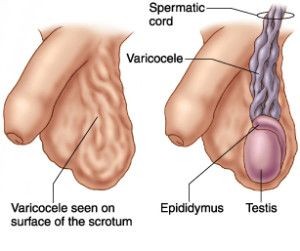It’s understandable to be concerned when you experience pain in your testicles, especially if it’s your left one. You might be lifting something heavy, working out, or even just going about your day when you notice a discomfort or ache. Questions race through your mind: Is it serious? Could it be something like cancer? What exactly is causing this pain in my left nut?
The good news is, often, the reason behind left testicle pain is a common and treatable condition called varicocele. A varicocele occurs when the veins in your scrotum, specifically those within the spermatic cord, don’t function as they should. Instead of blood circulating efficiently throughout your body, it pools in these veins. Varicoceles are quite prevalent and are associated with issues like infertility and reduced testosterone levels.
What’s Causing the Aches in My Left Testicle?
Interestingly, varicoceles are much more common on the left side, affecting about 85% of individuals with this condition. This predisposition to the left side is due to anatomical differences in the venous structure between the left and right testicles. The left renal vein, which drains blood from the left spermatic vein, is compressed by two arteries. This compression can restrict blood flow, leading to backpressure, especially if the valves within the veins are weak or dysfunctional. This backpressure causes the veins to dilate and enlarge, resulting in a varicocele and the associated left testicle pain.
In contrast, the right spermatic vein has a more direct and less obstructed pathway, draining directly into the inferior vena cava. This straighter route facilitates smoother blood flow, making varicoceles less likely to develop on the right side.
Can Varicocele Pain Affect the Right Testicle Too?
While left testicle pain due to varicocele is more typical, it’s definitely possible to experience varicocele in both testicles. These are known as bilateral varicoceles, and they can sometimes present a slightly greater challenge in terms of treatment. Although surgery remains an option for bilateral varicoceles, some men are concerned about post-operative pain, which can last for days or even weeks. Surgical procedures generally require a longer recovery period compared to minimally invasive treatments like varicocele embolization. Surgery recovery can extend up to two weeks, while embolization usually allows for a return to normal activities within just one to two days.
Is Left Nut Pain a Sign of a Serious Problem?
Although experiencing pain in your left testicle can be worrying, especially when you don’t know the cause, varicocele itself is usually not considered a serious health threat. Fortunately, it’s a condition that can be effectively treated. Varicoceles often begin to develop during puberty, with a significant incidence rate of 10% to 20% among adolescent boys. However, it’s important to note that if a varicocele appears suddenly in older men, or if you notice a testicular mass, it could, in rare cases, indicate a more serious underlying issue such as a retroperitoneal tumor obstructing the spermatic vein.
In cases of bilateral varicocele, a common observation is that the right testicle, despite being affected, may remain smaller in size compared to the left. It’s possible for the left side to present as a more severe grade 2 or 3 varicocele, while the right side might be a less pronounced grade 1.
What Treatments Are Available for Varicocele?
For men seeking relief from varicocele and associated left nut pain, there are several effective treatment options available, ranging from surgical to minimally invasive approaches.
-
Open Surgical Repair: This traditional method involves making an incision in the abdomen to directly access and repair the affected veins.
-
Microsurgery: Often favored due to its precision, microsurgery uses magnification to enhance the surgical field, leading to lower complication and recurrence rates.
-
Laparoscopic Surgery: This minimally invasive surgical technique employs specialized robotic instruments to perform the varicocelectomy through small incisions.
-
Varicocele Embolization: For those looking for a non-surgical and less invasive treatment, varicocele embolization is an excellent alternative. This procedure involves inserting a small catheter, typically through the groin, to block blood flow to the varicoceles. Blood is then redirected to healthy veins, restoring normal circulation and alleviating pain.
Varicocele Embolization vs. Surgical Options: Key Differences
Choosing the right treatment for varicocele depends on individual needs and preferences. Varicocele embolization offers several advantages over surgery. Embolization is often performed on an outpatient basis, meaning you can go home the same day, whereas surgical procedures might require a hospital stay. Procedure duration also differs significantly; embolization usually takes about an hour, while surgery can take up to four hours.
Recovery time is another important consideration. Embolization boasts a much shorter recovery, with many men resuming normal activities within one to two days. In contrast, surgical recovery typically takes two to three weeks. Regarding sexual activity, embolization patients are advised to wait one to two weeks, while surgical patients are usually advised to wait up to four weeks.
For men with bilateral varicoceles causing pain in both testicles, embolization offers a significant advantage. Both sides can be treated in a single session through just one puncture site. Surgical repair of bilateral varicoceles, while possible simultaneously, would require two separate incisions.
In conclusion, if you’re experiencing pain in your left nut, varicocele is a likely and treatable cause. While it can be uncomfortable and concerning, it’s generally not a serious condition. Effective treatments like varicocele embolization are available, often offering quicker recovery and less invasiveness than surgery. However, it’s crucial to consult with your doctor to accurately diagnose the cause of your testicular pain and determine the most appropriate treatment plan for you.
Sources:
[i] http://www.mayoclinic.org/diseases-conditions/varicocele/basics/definition/con-20024164
[ii] http://www.healthcommunities.com/varicocele/overview-of-varicocele.shtml

